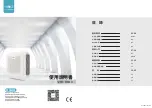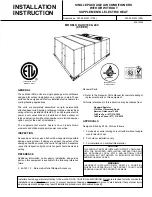
II - 2
(6) Coolant Level Check, Replenishment
Safety Precautions
Stopping only the indoor unit is extremely dangerous because the engine
may suddenly start if the customer operates the remote controller on the
indoor unit side. Before carrying out work on the inside of the outdoor unit,
make sure you turn off the power supply circuit breaker of the outdoor unit.
(However, if a system controller or other centralized control device is being
used, an abnormal communications error may be generated.) Alternatively,
perform the STOP operation for the outdoor unit.
j
Perform the coolant check and replenishment every 10,000 operating hours or 5
years, whichever comes first.
k
Use Sanyo Genuine Coolant solution (Figure 1).
l
The specified concentration for coolant solution is 50 ± 5%.
Caution
● Take care that the coolant solution does not enter the eyes or
mouth during work.
m
Preparations
The following tools, gauges, and materials are required for doing this work. Prepare them before starting.
Name
Specification
Q’ty
Remarks
Parts,
Materials
Sanyo genuine coolant
3-9509-1040
As needed SS Part code: 1743020
826-2-4521-10100
SS Part code: 1743030
Rags
Small q’ty
Tools Dispensing container
2 liters
For coolant (free from oil)
Gauges
Brine tester
For ethylene glycol
n
Check and replenish coolant
1) Check the coolant level inside the reserve tank from the cutout
of the side panel on the filler neck side of the unit. (Figure 2)
<Suitable Levels>
When warm : L level to maximum level during operation
When cold : L level to H level
2) If the level within the reserve tank is low, replenish the cool
-
ant with the specified concentration of genuine Sanyo coolant
(50 ±5%) up until the H level position.
a) Remove the coolant replenishment port cover on the top
panel, and then remove the rubber cap of the reserve tank.
(Figure 3)
b) Use the jug to replenish the coolant until the H level in the
reserve tank.
c) Reattach and tighten the rubber cap of reserve tank.
3) Wipe up any spilt coolant with a rag or the like.
4) Reattach the coolant replenishment port cover to the top panel.
Figure 1
Figure 3 Remove the rubber cap of the reserve tank
Coolant refill hole
Rubber cap
Coolant refill
hole cover
Figure 2 Checking the coolant level
H level
L level
Maximum level
during opera
-
tion














































